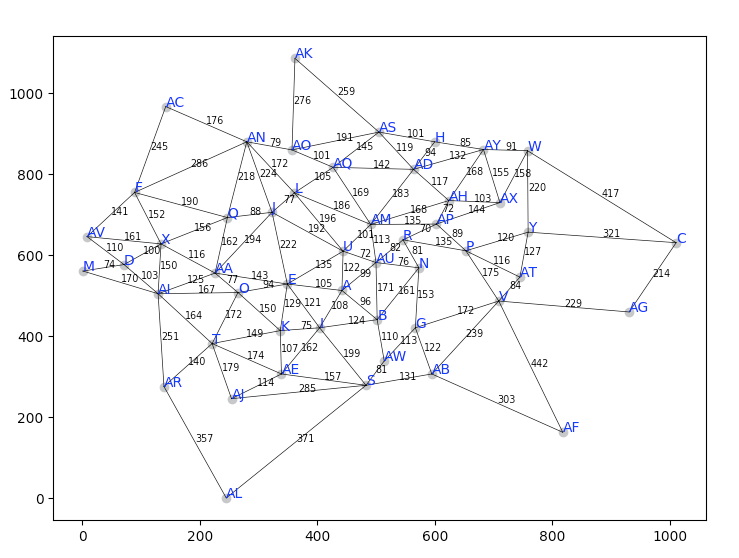
Test Map #2: A big, more complex urban landscape
Here is the file containing the map: 50test.txt
In this test, we are less interested in the detailed function of your searcher, and more interesting in some real world scenarios! We'll start with some simple point-to-point travel...and then move on to a cool "emergency services" scenario.
Scenario 2.1: Some simple point to point travel
This is the basic Google Maps scenario: You are at point A and want to get to point B...google maps should show you a route.
- Start=AG, Goal=F
- Set mode to verbose=Off. This should result in your searcher printing just the search type...and then the stats that resulted, just as in the 10node and 50node samples.
Run the following tests:
- Depth-first search
- Breadth-first search
- Best-first search
- A* search using your straight-line distance (hSLD) heuristic
Required output:
- Results from the tests are short now, so they can be printed continuously.
- Be sure to present the runs in the order shown above.
- Be sure to label each run clearly. Include some white space between each run's output to make it nice and readable.
Scenario 2.2: Emergency!
This is another common Google search scenario: you want to find a route to "the closest <whatever>". In this case, imagine that you are an ambulance at a bad accident, and need to find a route to the hospital....but there are three hospitals out there. Which route will your searcher return? Will your patient survive a non-optimal route?
- Set Start= "M", set goals = [C, AF, AK].
- Verbose mode is still OFF.
Run the following tests:
- Depth-first search
- Breadth-first search
- Best-first search
- A* search using your straight-line distance (hSLD) heuristic
- Oh no! You just heard the the hospital at AK is full!
Remove AK from the goal list and re-run (only) your A* search again. For this search only, include a screen snapshot of the resulting search graph, i.e., shows the graph with the found path showing in red.
Required output:
- Results from the tests are short now, so they can be printed continuously.
- Be sure to present the runs in the order shown above.
- Be sure to label each run clearly. Include some white space between each run's output to make it nice and readable.
Note for scenario 2: In the inconcievable case that you ignored the spec requiring the ability to set multiple goals to a search, please preface your output on this part with the following statement:
- "I failed to implement the ability to set multiple search goals, even though this was clearly stated in the project spec. As a result my searches in this scenario will all search only for the goal [ C ]". This way we can give you at least a small piece of partial credit.

